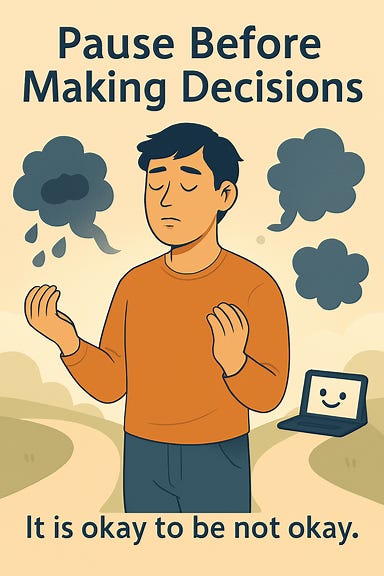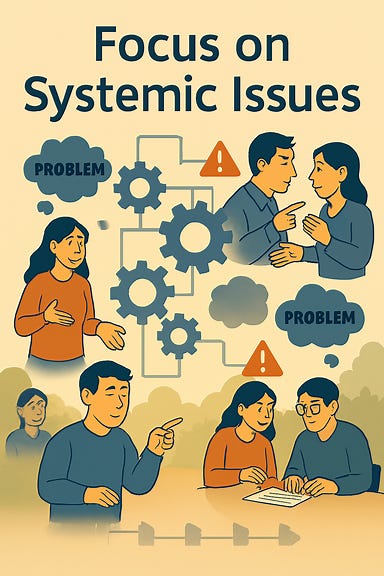Eliminate conflicts with transparency, Don’t Rush Decisions, and When Things Break, Blame the System
How do you turn adversaries into allies while protecting yourself? How do you avoid decisions you’ll regret for life? How do you keep the same problems from coming back again and again?
Full text: 1,300 words, reading time: 4 mins 25 secs.
There are only two ways to truly internalize knowledge:
Make mistakes (discover what you don’t know)
Digest and output (explain in your own words)
Inspired by Weekly I/O, I record my weekly learnings (or sudden insights) in bullet points and summaries. This forces me to keep growing—and I hope it helps you too.
This week, you’ll get
Eliminate conflicts with transparency
Sometimes, you’re just not ready to decide
When things go wrong, it’s always the system’s fault
1. Eliminate conflicts with transparency
I’ve lived through two kinds of friction:
Clashing with colleagues—tension spirals, communication dries up.
Facing “whisper tactics” from partners—spreading distrust between boss, client, and me.
The first is simple: two sides, two stances, collision is natural. My move?
Open the I/O
- Sit down, talk, share a meal, take a walk.
- It only works if both sides feel safe, not cornered. Otherwise, defenses stay up.
- Both must be willing to listen and speak.Lay feelings bare
- Invite the other to share. If they’re still guarded, show your own hand first.
- Speak with strict honesty—no blame, just sharing.
- After the exchange, ask: “How can we work together more smoothly?”
Example:
Hi Tom, seems our collaboration’s stuck. Can we talk about it? If you’re not ready, I’ll go first.No pressure, no obligation—just a chat.
On that project, our goals seem misaligned. Tension ran high in the meeting.
When you said XXX, I felt anxious, pressured, wanted to push back. That’s not your fault—it’s my own reaction, just worried about XXX.
Can you share how you feel? Maybe there’s something I’m missing.
(They share.)
So you felt XXX—I get it. What should I do differently next time? Here’s what I’d appreciate from you, too.
Don’t fear criticism. Be honest, ask for advice, seek smoother collaboration. Even the toughest will soften.
The second scenario is trickier. Same root—conflicting interests—but after I refused an unreasonable demand, the other side turned hostile: spreading misinformation, sowing suspicion, escalating pressure.
Upper management is busy, blind to details. When malice is obvious and dialogue fails, how do you protect yourself and still deliver?
Here’s what works:
Radical transparency
- Sync every decision and communication with everyone
- Use email CCs, group chats
- Invite all to join, even the antagonist.Write down the history
- Meeting notes shape reality. People are busy; your notes become the truth.
- Write smart, keep it concise.Don’t be evil
- Act with honesty, don’t fear mistakes or criticism.
- Your goal: protect yourself and the team, not to harm.
With kindness as your baseline, transparent, concise communication lets everyone access the facts. It kills the space for manipulation by information gaps, suspicion, or emotional pressure.
If someone suffers from your transparency, they’re the problem.
Key Takeaways
Honest openness isn’t weakness.
Under the light of transparency, malice cannot hide.
2. Sometimes, you’re just not ready to decide
I’ve made bad calls:
Hiding the truth to avoid blame.
Threatening to keep someone close.
Refusing to admit fault, shutting out feedback.
These choices brought shame and pain. The common thread? My state was terrible.
Emotions—stress, fear, pride—cloud judgment. I won’t tell you to erase emotion; that’s impossible. What matters is self-awareness and delaying decisions.
If you’re at a crossroads, exhausted and unsure, try this:
Check your body
- Are you tense, struggling to breathe? Mindfulness helps.Refuse to decide
- No decision is so urgent that the world will end if you wait.
- Push back on pressure: “I need time, I’ll reply by XXX.”Rethink
- Use AI, the best thinking partner of our era.
- I’ve used it for heartbreak, mind games, career choices.
- Unsure how to prompt? Feel free to have a chat with me.
If you can’t make a decision easily and calmly (good decisions don’t come with high emotion), you’re not ready.
It is okay to be not okay.
Key Takeaways
Before deciding, ask: “How am I right now?”
Don’t fall into the trap of forced decisions—those who push you aren’t on your side.
Use tools—AI is $20 a month, cheap as hell.
3. When things go wrong, it’s always the system’s fault
When trouble hits, does your environment focus on blaming someone, or on solving and preventing the issue?
There’s always that colleague or boss you wish would disappear. But if they’re gone, does the problem vanish? No. Another villain will appear, because the culture allows it.
So, is the problem the person—or the organization?
Same with couples, fighting the same fight, blaming each other for not seeing their effort, always feeling exploited. Does breaking up solve it? No. If you don’t grow, you’ll face the same challenge again. Life’s failed lessons get repeated.
So, is the problem your partner—or your communication and relationship system?
When things go wrong, it’s always the system, not the person. Because only systems:
Allow the same issues to recur.
Breed large-scale burnout, sap everyone’s spirit.
When you feel injustice or anger, ask: is this a system problem, or a person problem? Trust me—it’s always the system.
What you should really consider:
Can you change this broken system? Do you want to?
If you act, what’s the cost? Is the payoff worth it?
Key Takeaways
When trouble comes, hunt for the systemic source—blaming people only breeds conflict.
Once you clarify the system issue, think hard before you invest.
That’s what I’ve learned this week—if this helps you, all the better!
All images in this article were generated by Microsoft Copilot
All image prompts were created in collaboration with DIA Browser.



